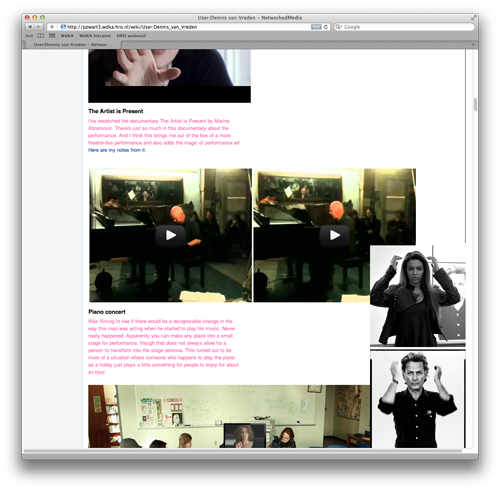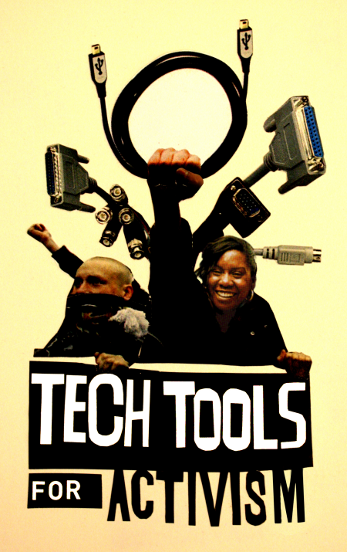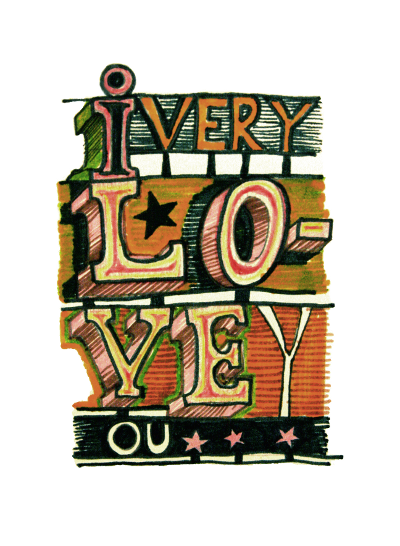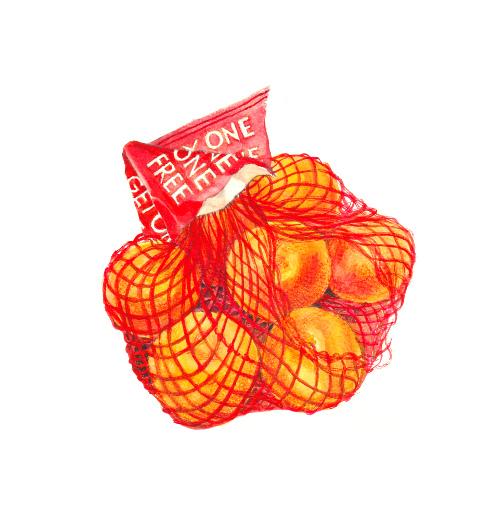User:Eleanorg/Journal 2.1
8 Dec
More theoretical clarification on graduation proposal (below). Also, a practical idea: 'safer spaces' policies as ideal target documents - controversial, collaborative statements about consent.
- Two contexts for the project:
- Feminist Consent proposals
- Web-to-Print / Atomization of Content
(linked to each other because both are about how to chose from a number of options)
- Print is moving to 'best of' role (Post Dig Print p.58); Online content needs curating too
- How to decide 'best of'? Various models:
- User curates own content: good use of aggregation, but creates individualist Filter Bubble
- Voting: (TheBlogPaper) creates populism - winners & losers; and BlogPaper relies on centralized platform
- Authors give resources: (Richard Kostelanetz 'Assembling Press') 'put your money where your mouth is'
- Readers give resources: (Amsterdam weekly)(Piracy Project) - 'vote with your wallet', more democratic
- curators decide: (Upworthy) paternalistic cop-out
- All these models share the problem that curation will always have: creating winners & losers, where most popular items rise and less popular ones fall. All miss the opportunity to stop and listen to other views - esp. marginalized ones.
(I've explored this before in Dissolute Img & Volunteer Hosts)
- Consent proposals offer another model: "not a series of proposals that meets with acceptance or rejection" (Millar, 2008 p.39)
- Question: How to agree if we scrap 'proposals', 'acceptance' & 'rejection'?
- Practical suggestion: Yes/No/Maybe game (Kramer Bussel 2008) << Alternative to hierarhcy-creating models above; instead best outcome is the most consensual one
4 Dec
Hey workblog, long time no see. So I've been writing the proposal, and getting my head straight re: theory + social context. Feel more comfortable with that now. Aim is: take feminist proposals about consent as a collaborative process, and push it further - when we collaborate, are we really autonomous individuals with autonomous desires? Applying these ideas of consensual collaboration online. Feminists debate amongst themselves what consent should mean, and the outcomes of this deliberation becomes a publication/s. Process-oriented, dialogue-based.
Question now is: does such a tool already exist? If so, what do I add? And, if not, how to make one? Need to better understand the following technologies:
- Wikis
- The king of collaborative writing tools, but how to get away from linear, chronological version control (or use it in new ways at least)
- Git
- How does it work. Who has used it in an artistic context. What social possibilities (forking etc) does it offer?
- P2P filesharing
- How to facilitate horizontal sharing through use of indexes & trackers
- Other collaboration tools
- LGRU are hot on this, what have they + others cooked up?
Next step, while reading up on these technologies/teaching myself how to use them, is to draft more specific spec and TRY it out in a workshop at PZI. A social process of assembling texts and rearranging them into little publications.
12 Nov
Tying off my Beautiful Soup learning with a speed project to generate placards. Current problem is how to generate nice-looking PDFs with flowable text.
7 Nov
review of where it's at
I started the trimester looking at the act of making copies (photocopying, transcribing, repeating), wondering about the subject-position of the copyer. Would people copy things exactly? What changes would they make?
This paralleled an earlier interest in embedding remote content - another form of making/distributing a copy of another person's document. I decided to pursue this topic more specifically, leaving aside other forms of verbal or visual repetition. My first 'social' (as opposed to technical) experiment was to facilitate an image-embedding 'pledge'. All participants embedded the same image; anyone could upload a new version on the wiki.
This started to move towards modelling what a 'porous' publishing model could look like, where publishing is done as an act of solidarity rather than simply amplifiying the views of a single individual. I think I'd like to launch this as a speed-project in my intended social context (feminist activism) - people opting-in to embed a changing feminist 'placard' on their websites.
At the same time I want to move onto developing a more self-contained publishing model/tool which uses this ethos to create publications. Both Aymeric and Michael have stressed the need to understand P2P protocols in order to do this sucessfully; as I'm still using client/server models that don't necessarily match the project's ethic.
That's an unresolved techincal issue. The unresolved social one is about the need for centralized control or curation (if this is a project I'll call my own); or the need for a social context (if this is a tool that I will release for use by others). Talking with David raised the question of 'audience', ie who is it for. Will I employ the activist tactic of saying: "no participation = nothing for you here"? Will this be for a closed group? Will the outcomes at least be relevant to a larger public, or not?
6 Nov
Tutorial with Michael:
- Django is a nice tool to easily sort/tag content & create flexible 'views'
- Scrapy.org is another framework for web scraping - check it out.
- Distributed embedding
- - how to shift from 'one to many' (Youtube) model of embedding to a p2p model?
- - compare bittorrent (p2p) with the one-way structure of a hypertext link - no two-way link
- - how to give participants access to an 'index' of participating peers?
- - privacy implications of amassing & curating content. possibility for abuse.
Tutorial with David:
- Who is 'the viewer' in this project?
- - will there be an outcome accessible to a random exhibition visitor, or is it a closed circle?
- - is a specific activist community the audience for this work, or are they making the work to share w/ a wider audience?
- - who is the PROCESS for (activist therapy?) and who is the OUTCOME for? (Activist lit, or something to share more widely?)
- Activist ethic: "contribute something to get something".
- - GOOD because it gets beyond passive art 'viewer'
- - BAD because it creates hierarchy of commitment; activist clique
26 Oct
On-the-fly books with changing content each time. Wrote a script that you tell a url and it writes the content from that url to a text file. Now going to gather feedback about the image embedding project to see how that could feed in.
25 Oct
it's official: Beautiful Soup and me are now an item.
what next then?
>> make a script where you can input a url and it grabs the body text from that url
>> learn how to insert text at a specific point in a document
>> learn how to convert .txt to .pdf
So you put in a url (or series of urls) and you get out a pdf file with various scraped content. continue with this next time. inputUrl.html is in public_html/urllib. The script it points to is in cgi-bin/urllib/makeScrapedText.cgi.
24 Oct
What prototype to create next? Things I've been thinking about/making include:
- Letting in unknown content on your own platform
- A tool to aggregate from other sites > 'scrapbooking'
- A tool that takes this various content and makes it into a pdf for POD -- no two editions the same
- Combining the above elements as a toolkit for making activist books (aggregation of content, conversion to POD format)
So the prototype question is: how to make something that grabs unpredictable content and converts to pdf? i.e. is there a way to hack Booki to make it do interesting things? Maybe you order the book before you know what's in it.
22 Oct
Hello little wiki. I've been learning how to use urllib and a bit of sgmllib. It's hurting my head a bit; hard to find comprehensive idiot's tutorials. Thinking maybe I should learn a bit about aggregating RSS feeds.
Liking how the image embedding experiment is going. How people are using it as a form of chatting, sharing (/generating) in-jokes, spamming, and most of all - today's image of a very very long thin line, which rearranges the layout of the pages on which it is embedded. In the case of Dennis' wiki, scrambling the image order as well and creating a nice layered effect (below - the embedded image is the thin black line on the right).
goodbye London IMC
The London IMC folks have posted some very thoughtful and relevant things about the changes in online publishing over the past decade, explaining why they're shutting up shop and moving onto other projects. The following bits resonate particularly and give me a sense of purpose; that I'm also responding to similar dilemmas with a similar ethic: ( annotation of the farewell message here)
"Digital communication today seems to be made up of a collective/singular active subject that approaches the 'we' form a clear 'I' identity."
"We in London see the challenges of today more in terms of collectivizing the individual outputs, of curating from within the sea of content, of fostering true collaboration and solidarity..."
what i want to do
me me me! me too I want to find ways of "collectivizing the individual outputs". Not just in a pragmatic/instrumentalist way but in a way that reflects upon the compromises & conflicts inherent in doing this. Be the Media folk say: the problem isn't helping people generate content, it's helping people find and organize the masses of content that's already out there. Is it the same for Radical X? A question of coordination between different minority groups, trying to create a stronger sex-positive movement that links up various struggles: pro-choice/trans struggles/gay rights/anti-rape/'informed consent' etc? Are there any platforms already attempting to do this (none spring to mind), and if there are what features do they need, in what ways could they be improved? (Again, not in the instrumentalist logic of "movement building" that so much radical media still shares, but as in "creating a deliberative space" - ie the aim of groups like Mutiny.) Need to get some quotes form Mutineers about why this deliberative space is useful.
21 Oct
I'm going to have a week of learning some code in order to clarify my thoughts about pulling content from other websites.
Basic idea: aggregation/scraping usually implies a power dynamic where the one scraping is in charge, curating incoming content. Can this be reversed, so that the page where data is aggregated to is conceived of as porous and vulnerable?+
+(possibly unrelated, parallel feminist debate: "why is it called penetration not reception/enveloping?")
++((possibly mental, parallel psychoanalysis: some tutor once said, "could this project have been made by a man?" <<stupid question or maybe not; is all this talk of porosity and vulnerability stemming from a fundamental ambivalence about the idea of penetration, what to let in/not let in?))
18 Oct
Happy sad rainy romantic blabla.
Watch this on networked economies: http://www.bbc.co.uk/programmes/b01n9yg1 Oggle at this: http://www.google.com/about/datacenters/gallery/#/
17 Oct
Spoke at NIMk last night about opening up authorship, embracing vulnerability and the anxiety of not being coherent, or being authored by others. This week's experiment with embedding directly relates. Currently 3 volunteers are embedding the image, and Dennis has changed it a couple of times.
Obviously this experiment requires social context, or it just becomes a formalist mashup exercise. But I'm really liking observing how people handled the invitation. Deliberately refused to give instructions about where and how to embed the image. Interesting that the two people posting it on their professional websites made a separate page for it, with context linking to my name - making clear it was a favor for someone else.
I think this exercise has real potential as a time-limited invitation to experiment with being uncomfortable, with giving up control over a portion of your online space. A method for ephemeral publishing to a specific group of people who've decided to participate. How could you make it technically so that only those who were currently embedding the image themselves could upload a new version?
Anxious lately about my interests being too broad, don't want to go up the Tunnel of Doom, Aymeric telling me to stop hopping about and choose something. But I want to synthesize rather than exclude; is that possible? Not sure where the thing about transcribing comes in; it has the potential to be something completely different. I have a formal fascination with this tedium, repetitive labour, tackling the vastness of thousands of tiny parts by hand even though it's effortless to automate these tasks with digital technology. Fascination with the scribe as a subject position.
scribing
things I want to try:
- write a pointless script that reproduces text 'manually' in the most inefficient way.
- write a script that somehow forces users to partake in this transcription
This is similar to what happens when you embed something, make yourself a portal (like a web browser) to another's ideas. Although with the image embedding, no repetitive labour is required - the updating is automatic, therein lies its beauty; that's how you lose control. When you have to manually reproduce, you have the chance for subversion and mis-copying.
works playing with transcribing:
{{#ev:youtube|vWtr9dBEhZc}}
"rewriting freud" by Christine Morris:
http://200ml.co.uk/2011/02/rewriting-freud/

porous publishing
Networked media means publishing can be collaborative, laying books open as porous objects. Relevant technical fields:
- Embedding files from other servers
- APIs to blur boundaries of one 'book' and another
- jQuery: responsive content
- POD - how does digital porosity relate to print? (Maybe transcribing is what can make print porous)
I'm finding the demand to justify, rationalize and defend at this stage unhelpful and paralyzing. Feels too early for a narrowing-down, I have my field, I know what components it's made up of, I need to play with them. If I can't synthesize them then some will be stored for later - but I can't know yet which to throw out.
In short I guess I'm interested in opening up the book - literally in terms of where its content is pulled from and also conceptually in terms of curatorial power - as a way into opening up the self.
15 ( )ct
Slogan-ring: first with images. Then try more sophisticated methods of including remote content.
Here's a test w/ an embedded img: 
Thoughts:
- how much to tell potential participants?
- wiki offers nice, central interface for uploading new versions of the file, and viewing old versions
- discipline of forcing people to keep img for certain amount of time, or let ppl upload new versions whenever they want?
l8r
I miss my laptop. Stressed. Worried that my area of interest is too broad; need to chat to L & A and other peeps who can help me focus it to a specific community. Was thinking that these ideas of 'transmitting others' and 'consent' are maybe two separate projects, but actually thinking about this 'Yes means yes' movement I think all this stuff about choosing slogans and 'acting in concert' becomes relevant because we're at the stage of movement-building, and what the hell does that mean? Can we act in concert without agreeing?
12 Oct
Thinking about contexts in which repetition is used. B & I brainstormed:
- church
- school
- political rallies (Marxist/fascist)
Got chatting about the decision-making process, how do you choose a slogan to shout together? B saying it's a powerful useful technique - why should right-wingers have monopoly on using it? - I'm more ambivalent.
Next experiment:
- Mutual slogan-ring
- > Process: You commit to posting an img file on your site. Img file is changed each week by ppl who've signed up to the scheme - if you want yours published, you have to publish others.
11 Oct
Been writing a lot, making more explicit what my interests and plans are. Steve said my plan sounds not vague but broad. True. It's a specific psychological phenomenon I'm interested in (the dilemma of whether to repeat other's words or speak your own, which in turn challenges the fixed boundary between the two). And this arises in many different contexts. I'm interested in techniques for setting aside individual subjectivity, 'channeling' others, and seeing what happens when we try in earnest to attempt this. Is it possible? Do we resist it? Is it useful, educational, ethical? It is dangerous?
Some techniques that come to mind for trying this out are:
- Stenography (Transcription of spoken words to text)
- 'writing lines' - copying a text by hand
- Verbal repetition (incl. callcentre work)
- Translation to Morse code
- Hosting data on a server
- Otherwise transmitting over interwebs << technical detail needed here!
Psychological techniques for open receptivity, setting aside ego:
- Freudian listening (accurate hearing of the other + neutral attendance to countertransference)
- Buddhist meditation
- Alienation in labour?
- Masochism
Maybe what I have been trying to do is to propose activities from the first list as exercises rather like those from the second - the point isn't the text produced/copied, but the experience of the copying itself.
And in trying out my prototypes it's become clear that there has to be some investment in the content in question; it needs to matter; there needs to be real conflict. Which means I need to work site-specifically or rather group-specifically, because those investments will vary between groups. So I guess to get towards a graduate project I need to keep in mind this broad theme, while choosing a particular context in which to explore it - because the phenomenon is meaningless without a context.
10 Oct
I've now done a braindump of where I'm at post-residency, and had a useful tutorial w/Steve. Next thing is to get on with Aymeric's daily experiments + cut & paste into grad proposal. Steve tutorial:
- 'consent' is ubiquitious online - constantly clicking 'i agree' - but I'm trying to problematize what that means
- what's the link to YR 1 interest in 'anxiety'? - the crisis of agency
- problematizing agency - we're not individual subjects
- Central paradox - joining group seems to mean surrendering autonomy, but actually we only gain autonomy/agency through the group
- Read Katherine Hales - my mother was a computer - talks about how code affects our agency and the anxiety provoked by 'participatory surveillance system'
- Tell stories about what I've done - what interested me, what situations i set up to test it, what happened (eg workshops, experiments etc)
- Jonathan Culler - 'Fortunes of the performative' - essays in Red reader in Black binder, reader for Amsterdam arts & humanities < traces history of the idea of 'performativity' (actions producing subjects)
8 Oct
Aymeric told us to do a thing a day. Simple protocol:
each daily "work" should have the following:
- it must relate to the domain of interest you have set for yourself earlier
- you must have a protocol for each experience: write quickly your intention, make something, write about the outcome simply and shortly (was it a success, a failure, why?)
- always use the previous days experiment as starting point for the new one.
For the record this assignment stems from an art and design practice that has several name: http://yaxu.org/hackpact/, http://creativepact.co.uk, http://thingaday2012.wordpress.com, http://www.inclusiveimprov.co.uk/doku.php/events:creativepact_2010
26 Sept
Narrowing my focus on subject-matter: the ability to copy/mimic/repeat as the basis for either:
- liberating/anti-individualist consensual democracy
or:
- alienated repetitive labour.
Have realized doing the first couple of prototypes that the content of this repetition/labour has to be site-specific, ie relevant and important to the group of people participating. Want to move back into doing more 'located' projects with small groups of people with shared interests. This way you get beyond the blank canvas/lowest common denominator of anonymous online participation. Q: how to incorporate this meetspace type approach into Radical X's interest in online space? Or: why is Radical X online? What is important about this, what benefits does it bring, what aspects of the internet are relevant to its projects?
LUX
Deciding how to use the space of this 'retreat' style residency. I like the idea of doing a small-scale book production experiment, from start to finish. The book will be a documentation of the residency, to be distributed to all participants. It will be made up of content generated through these collaborative/'consensual' exercises I've been researching. A model for book production that could be replicated by Radical X.
book binding
If the book's contents are multiple, distributed(?), how to bind them physically?
'Neckoracle' - fortune cookies & sacred string
Book as bodily object/ book as loose collection of leaves
23 Sept
Thoughts on deploying transcription prototype:
- one person thought it was a Captcha.
- * captcha results in sanction if text not copied verbatim - could a social equivalent exist? 'password' in the traditional sense, of signifying membership of a club - requiring an incantation
- * what is the implication of a Captcha with no sanction attached/ no 'wrong answer'?
<< tension/choice between forcing ppl to follow party line, or letting them deviate. what is the consequence of each?
- what to do when all are complete?
- forgot to allow for all transcriptions being done in my script so got an error. Interesting - why should it stop accepting new transcriptions when they've all been done? What about a rolling transcription where each image can be re-transcribed afresh?
- Typical responses to user input
- Exactly the same two types of responses as I've had with other 'user input' projects: 1. serious thoughtful contributions based on the content 2. 'wiki war'approach < testing/having fun with limits of the application, not the content. What is it in the interface that invites these two types of responses?
Photocopied editions is more of a general 'open source' project - many variations from one original. Doesn't make clear enough link to the issue of reproducing others' work, and what your stake in that is. Transcribing exercise is more clear as there is obviously the option to transcribe verbatim or not, with an implied expectation that you will copy it exactly. Importance of how the exercise is framed/introduced. Need to introduce a clear motive to participate & conflicting motives between faithfulness & deviation.
workshops
been wiki-stalking Dave; I like his idea of research-oriented workshops / workshop participants as guinea-pigs. Remembering LiWoLi workshop and thinking how to improve upon it. People deconstructed a symbol of authorship, but we didn't really talk so deeply about their own feelings of making, or force them to confront their own boundaries about authorship in the making. How could I design a workshop (eg for LUX) that would give ppl the opportunity to confront these boundaries and discover where resistance lies?
21 Sept
thoughts while making transcription prototype:
- why should images be of printed-out texts? This implies they were once digital so doens't make sense. should be hand-written.
- handwriting also introduces element of UNintended 'human error' - illegible handwriting etc
- how to get ppl to do it? Asking formal favour with known people probably makes them 'behave themselves' and do it properly. How to encourage/allow for deviation?
- link to 'digitization' more generally - libraries, archives scanning old books etc
- link to manual work - do workers consent to/endorse the things they produce? << alienation
- aesthetics of handmade stuff - I'm deliberately tearing/smudging etc to emphasise non-digitality. Why?
- incomplete sentences relate to the isolated pixels of Dissolute Image, intrigue of not knowing what you're contributing to - games like cadavre exquis where you don't see the whole until the end
20 Sept - l*88rrr**~
Read this on sources of the desire to self-publish: http://www.afterall.org/online/7239
Conditional design:
- use rules as constraints to get beyond individuality
- experiment with surrender to Other through rules
- visualise social principles - make them into codes for drawing
- Q: what are some basic principles of my practice? How to visualise them?
Crowd-sourcing has become advertising gimmick (Eg http://roelwouters.com/one-frame-of-fame) - appearance of democratic participation; 'open work' in the most conservative sense. But there is a substantial difference between giving rules in order to create a unified whole (Aaron Coblin et al) and using rules to set up certain social situations << this is much more interesting.
self-publishing not as self-promotion but as space for tactility/encounter with others. self-publishing against single author/single distributor/singular reader. multiple beings/incarnations/etc etc
20 Sept
Democratic artworks
A collection of projects that involve an element of 'democracy' in their creation - ie, including the voice/s of more than one creator. Comparing different models of 'user input'/collaboration/aggregation - from hierarchical curation all the way to unfiltered amplifier of crowdsourced content.
 >> Platform as neutral, unfiltered amplifier of public input
>> Platform as neutral, unfiltered amplifier of public input
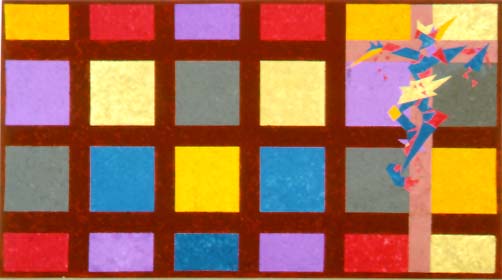
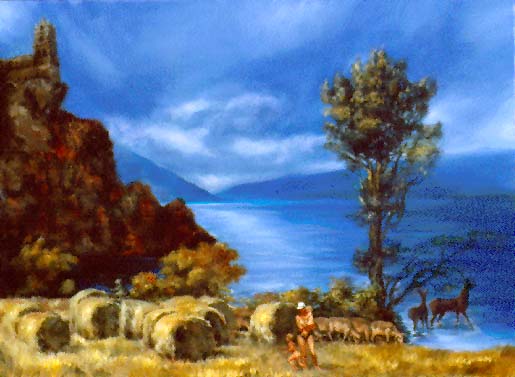
>> parody on the idea of voting leading to a coherent consensus, in visual form
 >> disparate fragments brought under one roof to create a totality. Relies on curation/filtering to become coherent.
>> disparate fragments brought under one roof to create a totality. Relies on curation/filtering to become coherent.
 >> nice approach of letting autonomous works form a collection via a common theme
>> nice approach of letting autonomous works form a collection via a common theme
 >> Problematic hierarchical curation hijacking 'democratic participation' discourse. But nice model of production - all in one room: interviews/print
>> Problematic hierarchical curation hijacking 'democratic participation' discourse. But nice model of production - all in one room: interviews/print
<iframe width="560" height="315" src="http://www.youtube.com/embed/viF-xuLrGvA?rel=0" frameborder="0" allowfullscreen></iframe>
Mass Labour
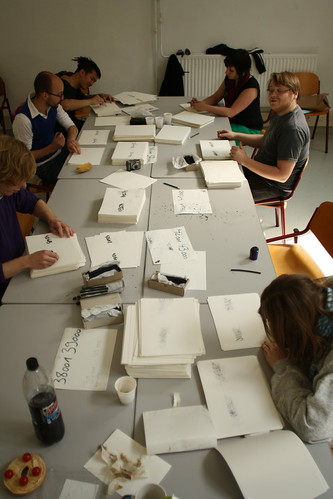 >> Roel Wouters' 2009 hand-numbered PZI catalogue.
>> Roel Wouters' 2009 hand-numbered PZI catalogue.
Roel Wouters // conditional design
Proposal for an activity: From http://conditionaldesign.org/
Construction of the Frame
Participants: In our case we were three people - Jonathan Roel and Luna. Every participant gets another participant appointed as a partner. Lead a conversation. During the conversation the partner has to note (in a text document) one word from each sentence of his 'master'. He is supposed to note the words that he finds interesting, specific or remarkable in some way. The notation will say something about both - the one noting the words as well as the one who speaks.
Conversation: Speak about "What do you think Conditional Design means to other people." The conversation should last ca. 20 - 30 minutes. At the end of the conversation each participant has a list of words he used noted by his partner.
Playing with the Frame:
Exchange the list of words you just created and take a list of words of someone else. Start anoter conversation with a topic that is close to you. When you speak use at least one word of your list per sentence. Use the First Step: The first player draws a line. The other players draw a line that goes over and under the last drawn line.
Knots
Technique for collaborative drawing
In Turns: The player elongates his/her line on both ends. The elongations have to go over and under a line of another player and may not go over the line of the same color twice in a row. When a line can no longer be elongated, it is considered dead for the rest of the game. When both ends of a line have died, the player may place a new line.
"Vitruvian Paint Machine"
>> nice variation on 'mic check' where artist becomes 'programmed' by others. Experiment with possbilities here of giving instruction/surrender to Other
Luna and Edo developed the Vitruvian Paint Machine for Take on me (take me on) an alternative production factory 17-25 october 2009, in the Van Abbemuseum, Eindhoven.
The Vitruvian Paint Machine invites the visitors of the Van Abbemuseum to use Luna and Edo as a vehicle for mural paintings, in accordance with several specific rules. These rules are all based on the proportions of the human body and the interaction with the visitors.
The visitors were asked to influence the painting by choosing one of the four colors: blue, red, green or black. The choosen bucket of paint had to be placed on top of a pillar. Luna and Edo then used the color to execute the according code.
Code to be executed by two painters on two ladders
COLOR RULES
If you you've been assigned a new color by a visitor, use the new color and its rules. Otherwise continue with your current color. Use the thin brush when there are 3 or less visitors in the room. Otherwise use the thick brush.
{{#ev:vimeo|4186304}}
we went to the beach
>> Straight from 'A Communications Primer' - feedback keeps crowds organized etc. Beautiful visual experiment {{#ev:vimeo|5311402}}
letting the manifesto speak through copic markers
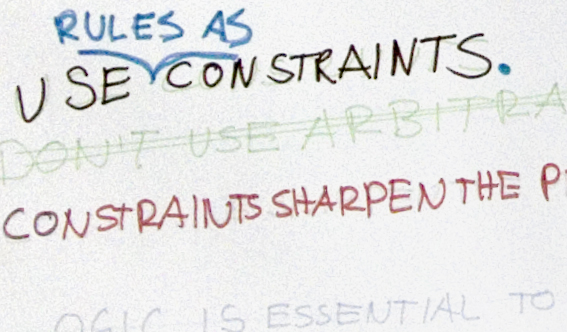
Instructions:
Write the sentence from the manifest from 1 to 17 according to the number you're given Write it with the according marker: the more you are sure of the words, the fresher and darker the marker you choose. If you are unsure, use a dry or light marker. All markers have to be used once. Go in rounds.
19 Sept
Read this on post-digital print: http://www.baltanlaboratories.org/?p=3773
18 Sept
Trying out my first paper prototype on Jasper. I mocked up a quick loose-leaf 'catalogue' of last year's work and asked him to make a second copy of it using the photocopier, saying he could alter the order or content if he wanted. time-limit of 15 minutes.
Thoughts while making:
- who chooses source material?
- does source material need to be 'democratically' chosen?
- ideally it would be crowdsourced - outsource the responsibility!
- specific instructions needed (& time limit helped too: "make a copy of this document in 10 minutes")
- content needs to be readily understood/relevant to audience (Eg at PZI, 'first year' catalogue images already familiar - can be quickly edited to taste)
- what is the motivation to make a copy? << ideological is nice but maybe financial too:
- "make a copy of this and sell it yourself" << micro-economies (Q: how does this relate to ideological budget cuts/"small state"/DIY labour?)
16 September
Blog post about 'Various Fires in Publishing' here: http://eleanorg.org/blog/vf
15 September
Interesting talk today @ Witte de With on self-publishing.
Most interesting q that came up was the irony of self-publishing supposedly being about resisting media monopolies, but without a readymade distro network you need to use FB to distribute - thus relying on/reinforcing media monopoly. Rob from Fucking Good Art seemed not to have much patience with this dilemma, being happily old-fashioned, talking about distributing through the networks of its writers and friends.
How many people need to have read something before it can be said to have been distributed? It's a matter of scale I guess, from total failure to roaring success, with vast grey zones in between. They were talking about the conscious turning-away of artists from hi tech and its parallels in networks like Path https://path.com/ - yuppified Facebook limited to 150 friends.
Interesting themes...
AND:
- Clash of DIY ethic/intention with DIY projects' reliance on FB for distro/marketing
- how then to create a meaningful r'ship with reader outside of the mediation of a shop (or FB)?
Marit Munzberg (LemonMelon):
- annagrammatical books/practice - rearranging, merging
- book as a verb or 'conceptual space'
- publishing = creation of the public > thus what is publishing's political role?
- can a book be a library? (link to dissolute img)
Rob (Fucking Good Art):
- Paper & bicycle/ network of friends distribution model
thoughts
Relevance of print publishing to digital dilemmas - especially the problem of distribution & promotion. Would be good to tie these things more closely together - for example, I like AND's Piracy project where people have to commit to printing a book themselves, thus 'bringing it back into print' quite literally. Strong link here to dissolute image & distributed hosting, where you outsource the commitment to promote or adopt something.
Also like the real-time book production, quickly printing screengrabs & pirate pad jottings. No fuss, just print & staple as quick documentation. experiment at LUX with these provisional ways of assembling stuff, gather things online then print them quick.
4 September
"Consent" The nights are drawing in, long sunshine, and yr 2 yr 2 yr 2 almost here!
Want to explore the idea of 'publishing' in a more focussed way. Over summer I've been making a book, a thing with staples in to make money by selling to people, and this question keeps coming up. Self-publishing, vanity publishing, print-on-demand, 'actual' publishing - I've never really understood what the difference is between putting ink on paper, and "really" publishing something. Maybe it becomes 'real' publishing when you add distribution into the equation?
Question: what is the difference between creating, disseminating, and publishing?
Why do people in the "age of the interweb" still lust after book deals? Not just money but a sign of success. Keep blogging and you could be the next EL James. What exactly is agreed upon in these book deals? Copyright traded for cash, printing + distro?
I've been reading those books they give to pre-teens about "growing up". Keeping it in your pants is mentioned a lot; consent, not so much. Always been a vague ambition to write one of those things. I mean, publish one of those things. How to do so in a consensual manner: Play!Fight! minus centralized control?
Been learning jQuery; images & text responsive to scripts, to distant events, to real objects. Easy to do on the internet, but how to do print publishing which is for want of a better word - ouch - "interactive"? ....why ouch? ---> trivial tokenistic participation; the 'open work' already designed & signed by the original author (oh yeah there's that thing about authorship again).
So actually yes the 'open work' -- touched on this in my dissertation; open work not really open, who gets the by-line at the end of the day?
How to integrate PZI coding into print media. Talk to OSP. Look at Fluxus kits and all that. Interactive books (As precursors to video games). And video games as precursors to...? What place now for "choose your own adventure" books? Thinking of factories and Florian, methods for making stuff.
What next:
- Get examples of "interactive" print media
- learn how e-publishing works
- learn how print on demand works
2 Aug
Dissolute Image: appending image attributes with jQuery to allow incremental page-load: http://ox4.org/~charlie/image_block.html
1 Aug
Summer!
And what do I do when I get out of school; I make papier mache obviously. And here I was about to run off to a commune in the hills to make papier mache happily ever after, when I remembered the things I made in the first trimester here and how there could be some link between:
HANDMADE IMAGES and THE INTERNET
my dirty secret
good at this point to come clean and see what happens when the world of beautiful objects tries to fit into the world of PZI geekery. This is what I get up to in my spare time:

Yes I made that last one with a paintbrush.
networked graphics
There seems to be some irreparable divide between the joy of making stuff with paper + glue and the cold hard world of code. Unless you go down the road of Arduino joy obviously. But staying within the browser: all the time at PZI I've been buzzing like a reluctant bee around this question of how images could be made porous and responsive. Maybe here there is a way forward that could start to heal the chronic split between my love of drawing + handmade messiness and my curiosity about programming.
Consent
"Consent", my proposal for a magazine with responsive content - thus democratically curated - is in the same vein here. Images fade out when they are unpopular, etc. Similar to the traceroute project where the appearance of a thing corresponds to its location. I think the way forward is to get to grips better with jQuery, and use it for a few illustration projects.

